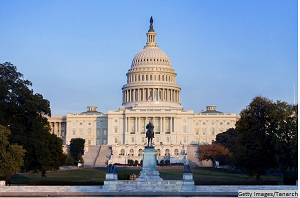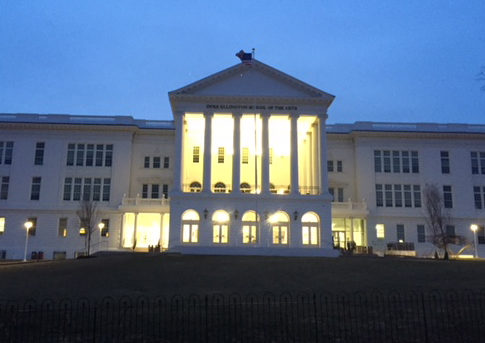It’s crunch time for the new Every Student Succeeds Act (ESSA). The week before Thanksgiving, months of intense negotiations yielded a House and Senate deal on their competing bills to overhaul the No Child Left Behind Act. The ESSA will, in short order, get an up-or-down vote in each chamber. In judging the merits of the final deal, it’s important to keep in mind what an appropriate and effective federal role in education entails.
A bit of history can help. In 1965, as part of President Lyndon Johnson’s War on Poverty, Congress passed the Elementary and Secondary Education Act (ESEA). Johnson hoped that ESEA would boost the achievement of disadvantaged students, helping to break the cycle of poverty. ESEA failed to deliver on that promise. No one knew whether federal money was doing any good, even as rules, regulations, and bureaucracy proliferated. Meanwhile, schools found it all too easy to overlook or ignore disadvantaged students.
In 2001, President George W. Bush and key congressional Democrats wanted to ensure that federal funds were being used effectively and that vulnerable children would no longer be overlooked. Unfortunately, the bipartisan NCLB that they settled upon was a flawed (if well-intentioned) mash-up. Remarkably intrusive, it was especially prescriptive about how states would measure school performance and what states would do to schools deemed “in need of improvement.” Absurdly, NCLB required that 100 percent (!) of the nation’s children be “proficient” in reading and math by 2014, with mandated consequences for schools that missed the bar.
Ultimately, NCLB allowed the Obama administration to dictate K-12 policy via quid pro quo waivers granted to states desperate to escape NCLB’s “100-percent” mandate. The Secretary of Education released dozens of states from NCLB’s fantasy targets if—and only if—they promised to pursue Obama priorities. The problem with that? Setting aside niceties of constitutional propriety, the salient point is that because Washington doesn’t run America’s schools, all it can do is pen rules for schools, which yields ham-handed directives and compliance-inducing bureaucracy. When it comes to complex enterprises like public schooling, whether things are done often matters far less than how they are done. Even Washington’s best efforts wind up suffusing schools in red tape and undermining the ability of educators to make sensible decisions. Given that, here are the ways I think it’s most helpful to judge the new law:
Does it promote transparency? For all its flaws, NCLB does have one invaluable legacy. By requiring states to test in the same subjects and grades, Congress created a framework for the public to see how schools are doing. Setting forth this kind of framework is entirely consistent with Congress’s responsibilities under the “weights and measures” provision of the Constitution. Moreover, data reporting and analysis pose minimal implementation headaches, do not involve the feds in dictating practice or monitoring compliance, and equip the public to set priorities and make decisions. ESSA retains NCLB’s requirement that states continue the once-a-year testing requirement that NCLB had for reading and math (in grades 3-8 and once in high school) and science (once in elementary, middle, and high school). ESSA also continues to require states to disaggregate and report the results for a variety of demographic subgroups.
Does it end federal efforts to micro-manage school improvement? It was a mistake for NCLB to get Washington into the business of trying to determine which schools are making “adequate yearly progress” and what to do about those that are not. States do an uneven job of flagging troubled schools, but even the most self-impressed Beltway wonk should by now recognize that Washington is no better at this task. Crafting a national law that can apply to 100,000 schools in 50 states means metrics are inevitably going to be clumsy and applied in capricious ways. And, unlike when state and local leaders create targets, Washington is not held accountable for meeting them—local and state leaders are. Mayors, superintendents, principals, and CEOs set targets and then are held responsible for meeting them, which encourages setting targets that are realistic and owning the consequences. When federal officials insist on “accountability,” these are just politicians and bureaucrats mouthing off. They know that there’s no reciprocal accountability to states and that no one imagines they’re accountable for what happens in a given state or system. That’s how we end up with ridiculous, counterproductive targets. Happily, ESSA gets Washington out of the accountability business, although it does leave much more compliance-inducing vague guidance about what states “should” do than is optimal.
Does it enable states to expand school choice? As states increasingly adopt choice-based models, ranging from Nevada’s Education Savings Accounts to Louisiana’s “course choice” programs, Congress should adapt funding requirements to ensure that federal funds serve the intended beneficiaries without tying states’ hands. One sensible move would be to embrace full Title I portability, so that states can use federal funds to help low-income students attend the district, charter, or private school of their choice. Unfortunately, private school portability never went anywhere and the House’s public portability provision got dropped in ESSA. More promisingly, ESSA allows up to 50 local education agencies to experiment with weighted student funding models that would make all federal, state, and local funds portable.
Does it get the feds out of the teacher business? NCLB’s Highly Qualified Teacher provision was a well-intentioned mistake. There’s no constructive way for federal lawmakers to issue guidelines for judging whether three-and-a-half-million teachers are good at their jobs. The inevitable result is more rules, paperwork, bureaucracy, and a raft of not-ready-for-primetime teacher evaluation systems. Congress doesn’t try to tell its employees in the military or the Justice Department how to determine who is a qualified soldier or public attorney; it leaves that judgment to the professionals. The same philosophy should apply when it comes to educators who don’t work for the federal government, and ESSA does put that decision back into the hands of states and local government.
On the whole, it seems to me that ESSA does reasonably well on this scorecard. It retains the big thing that NCLB got right for students (e.g. transparency) while stripping away ham-fisted dictates that created problems for students and schools. It ensures that important decisions will be made by those closer to the situation and accountable for their handiwork. ESSA doesn’t come close to getting it all right, but it’s a vast improvement on NCLB and the status quo.
– Rick Hess
This first appeared on Rick Hess Straight Up. An earlier version of the piece was published at Spotlight by the Center for Law and Social Policy. You can find the link here.





